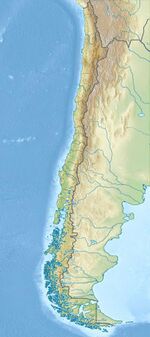Earth:Tralcán Formation
| Tralcán Formation Stratigraphic range: Rhaetian | |
|---|---|
| Type | Geological formation |
| Underlies | Quaternary glacial deposits |
| Overlies | Trafún Metamorphic Complex |
| Thickness | >800 m (2,600 ft) |
| Lithology | |
| Primary | Conglomerate, sandstone, mudstone |
| Other | Shale |
| Location | |
| Coordinates | [ ⚑ ] : 39°48′S 72°30′W / 39.8°S 72.5°W |
| Region | Los Ríos Region |
| Country | |
| Type section | |
| Named for | Tralcán |
| Named by | Aguirre & Levi |
| Year defined | 1964 |
Tralcán Formation (Spanish: Formación Tralcán) is a sedimentary formation of Triassic age in Los Ríos Region in south–central Chile. It overlies unconformably the Trafún Metamorphic Complex. Tralcán Formation and nearby Panguipulli Formation form possibly the remnants of an ancient lake and river system. The formation is named after Mount Tralcán on the western edge of Riñihue Lake.[1]
Description
The Tralcán Formation was first defined by Aguirre and Levi in 1964, based on the outcrop at Tralcán. The more than 800 metres (2,600 ft)[1] thick formation comprises reddish-grey conglomerates with a sandy matrix and intercalated reddish shales. The shales of the formation contain abundant fossil flora. Fossils of Cladophlebistenia oeshi have helped to redefine the age of the formation, that was formerly considered Late Jurassic (Kimmeridgian to Tithonian), to the Rhaetian of the Triassic.[2]
Fossil content
The following genera of fossil flora have been identified in the formation:[1]
- Asterotheca
- Cladophlebis
- Dicroidium
- Ginkgoites
- Gleichenites
- Heidiphyllum
- Johnstonia
- Lepidopteris
- Linguifolium
- Neocalamites
- Phoenicopsis
- Pseudoctenis
- Pterophyllum
- Rissikia
- Sphenobaiera
- Taeniopteris
References
- ↑ Jump up to: 1.0 1.1 1.2 Herbst et al., 2005
- ↑ Di Biase & Lillo, 1973, p.12
Bibliography
- Di Biase F., Francisco, and Fernanda Lillo R.. 1973. Geología Regional, Geoquímica de Drenaje y Minería de la Provincia de Valdivia, 1–101. Instituto de Investigación de Recursos Naturales. Accessed 2019-02-21.
- Herbst, Rafael; Alejandro Troncoso, and Jorge Muñoz. 2005. Las tafofloras triásicas de la región de los Lagos, Xma Región, Chile. Ameghiniana 42. . Accessed 2019-02-21.
 |


